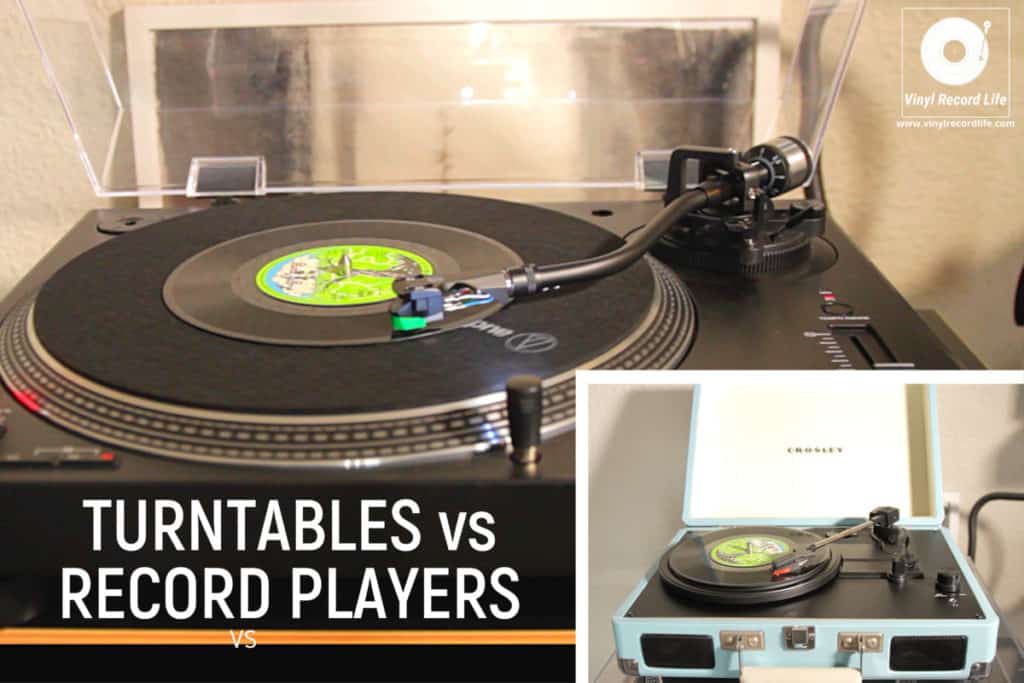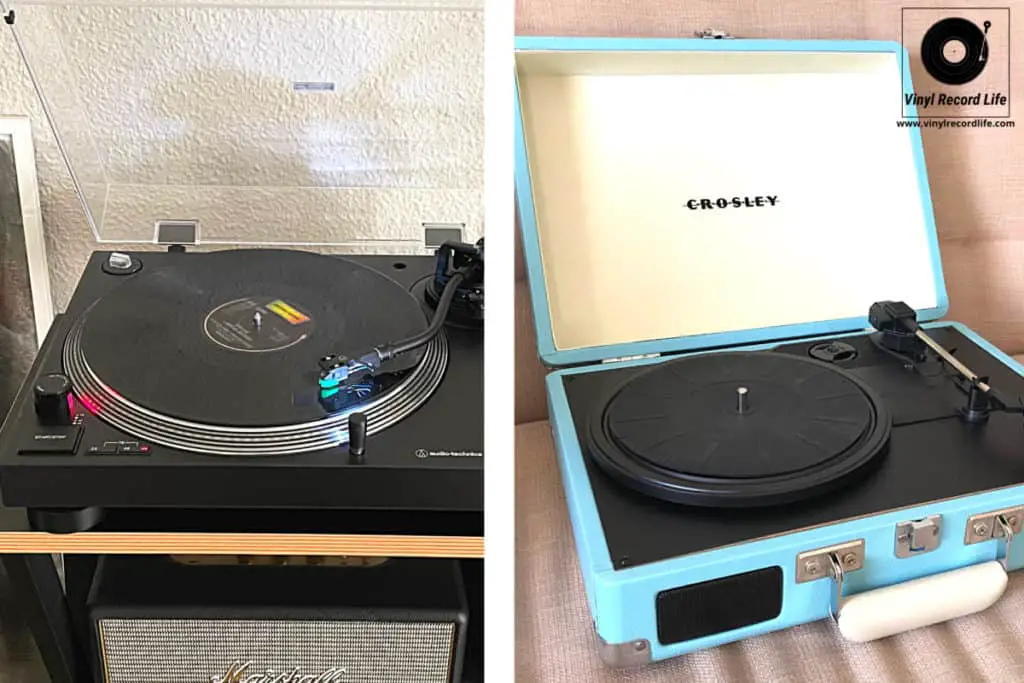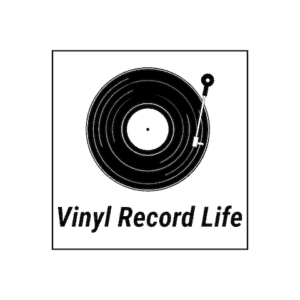Something you’ve probably encountered when reading (or watching) content about records and the world of vinyl is the frequent use of the terms turntable and record player, but without much clarification around the differences between them.
Both terms are often used indiscriminately, and I’ve used them interchangeably on this blog when discussing various themes and topics. If you don’t know the difference between the two it’s easy to get confused, and to wonder whether there is any distinction at all.
A turntable comprises a platter, tonearm and cartridge, and operates as a standalone unit which requires additional components to play music. A record player is an all-in-one unit that does not need external components, as it already includes the turntable assembly, preamp, amplifier and speakers.
It’s also important to understand the nuances around the use of the term “turntable”, as it can be used to refer to a specific component of a record player, but has evolved in recent times to refer more often to the standalone unit that is hooked up to other equipment, either as part of a more elaborate stereo system, or as part of a DJ-style set-up.
There’s plenty to clarify and understand around the differences between a record player and turntable and the pros and cons, and that’s what we’ll address in detail in this article.

What Is a Turntable?
The term turntable can be used in two main contexts: to refer to an integral component of a record player, or as the name of a standalone unit.
As an element of a record player, it simply helps to form part of the overall unit. As a standalone, a turntable is combined with other equipment and external components to form a system, or set-up.
A turntable assembly in its purest sense is made up of a platter (upon which the record sits), a tonearm and a cartridge. In theory, a turntable is that simple: it’s just a combination of the most basic elements needed to enable a record to be spun and transfer the sound from its grooves to some form of output.
When referred to in the context of being standalone unit, a turntable will be made up of the platter, tonearm and cartridge mounted onto a base, or a plinth.
Most turntables will have a preamp built in, but will need an external amplifier and speakers, which need to be bought separately and connected to the turntable. The in-built preamp can often be bypassed, with a lot of users preferring to have an external preamp of their choosing.
Audiophiles and music enthusiasts who are really into achieving the best possible sound from a set-up will often mix and match the very best external components with their turntable, getting higher quality sound through the customization that this greater control over components allows.
For this reason, a turntable is often the preferred choice of audiophiles and record collectors.
In general, when you see or hear the term turntable being used it will mean the standalone unit, unless specifically referred to in the context of the make-up of a record player.
Understanding How a Turntable Works
Turntables are relatively simple pieces of equipment, and their mechanical operation is a straightforward process.
When the record is placed on the platter, it’s secured in place by the spindle and the slip-mat. These, in combination, help to avoid the record moving or sliding once the platter begins to rotate.
When the platter is in motion, the tonearm is then moved into place above the record, and gently lowered. This brings the stylus – the needle – into contact with the record’s surface.
The stylus is housed in the cartridge, which is connected to the end of the tonearm (find out more about tonearm assembly here).
When the stylus engages with the record surface, it settles into the grooves of the record. As it tracks those grooves it passes the vibrations to the cartridge, via the cantilever, and the cartridge then converts those movements into an electric signal thanks to the magnets and wire coils contained within.
The electric signal created is called a PHONO signal, which is too quiet to be heard at this stage of the process. This is where external components and equipment come into play with a turntable.
A lot of turntables have an in-built preamp, which converts this PHONO signal to a LINE signal before passing it along. However, many turntable users prefer to use an external preamp, and this is the point at which additional equipment comes into play.
Once the signal has been converted from PHONO to LINE, whether that’s via an internal or external preamp, the rest of the process happens away from the turntable. An amplifier will then take the signal and pass it to speakers, although some speakers have an amplifier built into them. This is where audiophiles and enthusiasts really get into fine-tuning their set-up to their specific demands.
With regards to the mechanics of a turntable, there are two main methods in which the platter is driven: direct-drive, or belt-drive.
Direct-drive turntables have a motor underneath the platter, which rotates the platter directly, whereas belt-drive turntables use a pulley system to connect the motor to the platter. You can find out more about how these operate here.

What Is a Record Player?
A record player is an all-in-one solution that contains all the components required to be able to play music from a record, without the need for any external components.
A turntable (in this context referred to as a component of the record player) with the parts as outlined in the previous section, along with an amplifier and speaker are all included in a record player. Often there’s no need for extra cables, external components or anything else – it’s a case of plug in and play.
Modern record players can also have other elements integrated into them, such as a radio, Bluetooth, USB connectivity and more. They’re also much more portable than a turntable, as newer models come in a suitcase-style format.
Understanding Some Important Differences of a Record Player Compared to a Turntable
The drawbacks with a record player often center on the lack of flexibility around upgrading components to improve sound. Record players are usually a much more affordable option, and as such the stock components they come fitted with can be of a much lower quality. This usually translates into poorer sound quality.
There is also often a lack of ability to fine tune things such as tracking force (the weight the stylus applies to the record surface) and the alignment of the cartridge. As well as affecting sound quality, the incapability to control these elements can lead to damage to records.
Turntable Vs Record Player: Which is Better? A Quick Sound Test
At home, we’ve got a few different options for playing records, from turntables with decent speaker set-ups, to a couple of record players we’ve acquired down the years.
For the purposes of a quick and easy (and very non-scientific!) test, I fixed up the most basic turntable arrangement alongside a cheap and basic record player, to try and create as equal and fair a direct comparison as possible.
| Turntable set-up | Record Player set-up |
| > Audio Technica AT-LP120XUSB > Marshall Stanmore speaker | > Crosley CR8005A-TU |
The video plays the same 10-second intro on both set-ups back-to-back, to enable you to hear the differences in sound quality on the exact same section of music, and then switches back and forth between the two set-ups so that you can hear how the sound differs when listening continuously.
Those differences that you can quite clearly hear in sound quality, despite this quick test being run in an uncontrolled environment, can be explained when making a head-to-head comparison between turntables and record players in some key areas…
Turntable vs Record Player: A Head-to-head comparison
There are several areas in which direct comparisons can be made between record players and turntables, but there is also a certain degree of nuance to be accounted for depending on specific requirements an individual may have.
Components and Build Quality
Turntables tend to be of a higher quality, in terms of the build but also the components used. Higher quality parts result in a more durable and longer-lasting product.
The majority of modern record players cut corners on cost in the production process, and as a result are poorer quality. Cheap turntables are also available, and the low price will reflect the build quality, but in general turntables are better quality than record players.
The Actual Sound
Surely the most important element, right? You listen to vinyl because you want to appreciate all the nuanced delights that the format delivers.
This is an area where turntables will almost always win, hands down. The above video demo gives a fairly simple conclusion to this.
Turntables, with their higher quality components right out of the box, produce better sound. The endless possibilities for combining a turntable with external equipment of better quality, means there is a flexibility that turntables offer. You can buy a decent turntable for $250, for example, and pair it with a quality pair of speakers that you can then upgrade at any point.
A good entry-level turntable for a very reasonable price (around the $150 mark) is the Audio-Technica AT-LP60X-GM, which provides a reliable, well-built unit for an affordable amount.
With a record player, the options are extremely limited on this front, and you are usually stuck with what you get out of the box. Combine this with the fact that the in-built components of a record player, such as the speakers, are usually very low quality, the sound will be tinny and not deliver a pleasurable listening experience.
The Cost: You Get What You Pay For
Sure, a turntable will cost you more money and will require further expenditure on external components, but the long-term cost is worth it, as it’s more of an investment. Plus, you can spend what you can afford on a set of speakers, for example, and then upgrade at a later date because your turntable will stand the test of time.
Record players may be a cheaper option, but they are less durable, and they usually have a detrimental effect on records.
The Impact on Your Records
That leads us into another area that requires serious consideration: the wear and tear on your record collection.
A turntable, with its tonearm set at the correct tracking weight and quality stylus, will be far kinder to your records than a cheap record player’s stylus, which cannot have its tracking force adjusted and which will therefore cause damage to your records.
In my opinion, turntables win on every front, both in terms of the quality of listening experience (by a long shot!) but also for the long-term investment.
